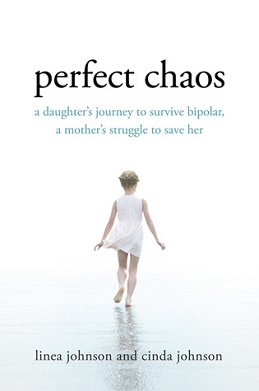
Bipolar disorder, previously known as manic depression, is a mental disorder characterized by periods of depression and periods of abnormally elevated mood that each last from days to weeks. If the elevated mood is severe or associated with psychosis, it is called mania; if it is less severe and does not significantly affect functioning, it is called hypomania. During mania, an individual behaves or feels abnormally energetic, happy or irritable, and they often make impulsive decisions with little regard for the consequences. There is usually also a reduced need for sleep during manic phases. During periods of depression, the individual may experience crying and have a negative outlook on life and poor eye contact with others. The risk of suicide is high; over a period of 20 years, 6% of those with bipolar disorder died by suicide, while 30–40% engaged in self-harm. Other mental health issues, such as anxiety disorders and substance use disorders, are commonly associated with bipolar disorder.
Bipolar I disorder is a type of bipolar spectrum disorder characterized by the occurrence of at least one manic episode, with or without mixed or psychotic features. Most people also, at other times, have one or more depressive episodes. Typically, these manic episodes can last at least 7 days for most of each day to the extent that the individual may need medical attention. Also, the depressive episodes will be approximately 2 weeks long.

Kay Redfield Jamison is an American clinical psychologist and writer. Her work has centered on bipolar disorder, which she has had since her early adulthood. She holds the post of the Dalio Professor in Mood Disorders and Psychiatry at Johns Hopkins University School of Medicine and is an Honorary Professor of English at the University of St Andrews.

A mental disorder is an impairment of the mind disrupting normal thinking, feeling, mood, behavior, or social interactions, and accompanied by significant distress or dysfunction. The causes of mental disorders are very complex and vary depending on the particular disorder and the individual. Although the causes of most mental disorders are not fully understood, researchers have identified a variety of biological, psychological, and environmental factors that can contribute to the development or progression of mental disorders. Most mental disorders result in a combination of several different factors rather than just a single factor.

A mood disorder, also known as an affective disorder, is any of a group of conditions of mental and behavioral disorder where a disturbance in the person's mood is the main underlying feature. The classification is in the Diagnostic and Statistical Manual of Mental Disorders (DSM) and International Classification of Diseases (ICD).
A psychiatric or psychotropic medication is a psychoactive drug taken to exert an effect on the chemical makeup of the brain and nervous system. Thus, these medications are used to treat mental illnesses. These medications are typically made of synthetic chemical compounds and are usually prescribed in psychiatric settings, potentially involuntarily during commitment. Since the mid-20th century, such medications have been leading treatments for a broad range of mental disorders and have decreased the need for long-term hospitalization, thereby lowering the cost of mental health care. The recidivism or rehospitalization of the mentally ill is at a high rate in many countries, and the reasons for the relapses are under research.
Schizoaffective disorder is a mental disorder characterized by abnormal thought processes and an unstable mood. This diagnosis requires symptoms of both schizophrenia and a mood disorder: either bipolar disorder or depression. The main criterion is the presence of psychotic symptoms for at least two weeks without any mood symptoms. Schizoaffective disorder can often be misdiagnosed when the correct diagnosis may be psychotic depression, bipolar I disorder, schizophreniform disorder, or schizophrenia. This is a problem as treatment and prognosis differ greatly for most of these diagnoses.

Links between creativity and mental health have been extensively discussed and studied by psychologists and other researchers for centuries. Parallels can be drawn to connect creativity to major mental disorders including bipolar disorder, schizophrenia, major depressive disorder, anxiety disorder, OCD and ADHD. For example, studies have demonstrated correlations between creative occupations and people living with mental illness. There are cases that support the idea that mental illness can aid in creativity, but it is also generally agreed that mental illness does not have to be present for creativity to exist.
Dysphoria is a profound state of unease or dissatisfaction. It is the semantic opposite of euphoria. In a psychiatric context, dysphoria may accompany depression, anxiety, or agitation.
Partial hospitalization, also known as PHP, is a type of program used to treat mental illness and substance abuse. In partial hospitalization, the patient continues to reside at home, but commutes to a treatment center up to seven days a week. Partial hospitalization focuses on the overall treatment of the individual and is intended to avert or reduce in-patient hospitalization.

Bipolar disorder in children, or pediatric bipolar disorder (PBD), is a rare mental disorder in children and adolescents. The diagnosis of bipolar disorder in children has been heavily debated for many reasons including the potential harmful effects of adult bipolar medication use for children. PBD is similar to bipolar disorder (BD) in adults, and has been proposed as an explanation for periods of extreme shifts in mood called mood episodes. These shifts alternate between periods of depressed or irritable moods and periods of abnormally elevated moods called manic or hypomanic episodes. Mixed mood episodes can occur when a child or adolescent with PBD experiences depressive and manic symptoms simultaneously. Mood episodes of children and adolescents with PBD are different from general shifts in mood experienced by children and adolescents because mood episodes last for long periods of time and cause severe disruptions to an individual's life. There are three known forms of PBD: Bipolar I, Bipolar II, and Bipolar Not Otherwise Specified (NOS). The average age of onset of PBD remains unclear, but reported age of onset ranges from 5 years of age to 19 years of age. PBD is typically more severe and has a poorer prognosis than bipolar disorder with onset in late-adolescence or adulthood.
Bipolar II disorder (BP-II) is a mood disorder on the bipolar spectrum, characterized by at least one episode of hypomania and at least one episode of major depression. Diagnosis for BP-II requires that the individual must never have experienced a full manic episode. Otherwise, one manic episode meets the criteria for bipolar I disorder (BP-I).

Postpartum psychosis (PPP), also known as puerperal psychosis or peripartum psychosis, involves the abrupt onset of psychotic symptoms shortly following childbirth, typically within two weeks of delivery but less than 4 weeks postpartum. PPP is a condition currently represented under "Brief Psychotic Disorder" in the Diagnostic and Statistical Manual of Mental Disorders, Volume V (DSM-V). Symptoms may include delusions, hallucinations, disorganized speech, and/or abnormal motor behavior. Other symptoms frequently associated with PPP include confusion, disorganized thought, severe difficulty sleeping, variations of mood disorders, as well as cognitive features such as consciousness that comes and goes or disorientation.
Joseph Biederman was Chief of the Clinical and Research Programs in Pediatric Psychopharmacology and Adult ADHD at the Massachusetts General Hospital and a professor of psychiatry at Harvard Medical School. Biederman was board-certified in general and child psychiatry.

Scattershot: My Bipolar Family is a 2008 memoir, written by American writer, carpenter, and former Montague Bookmill proprietor David Lovelace, published by Dutton Adult. Lovelace's memoir chronicles the challenges of growing up in a family in which four out of five members suffer from bipolar disorder, including Lovelace himself. Only his sister, who is a professional therapist, was spared the ravages of bipolar disorder, while both his parents, his brother, and himself, have suffered to differing degrees over the years.
The associated features of bipolar disorder are clinical phenomena that often accompany bipolar disorder (BD) but are not part of the diagnostic criteria for the disorder. There are several childhood precursors in children who later receive a diagnosis of bipolar disorder. They may show subtle early traits such as mood abnormalities, full major depressive episodes, and attention-deficit hyperactivity disorder. BD is also accompanied by changes in cognition processes and abilities. This includes reduced attentional and executive capabilities and impaired memory. How the individual processes the world also depends on the phase of the disorder, with differential characteristics between the manic, hypomanic and depressive states. Some studies have found a significant association between bipolar disorder and creativity.

Disruptive mood dysregulation disorder (DMDD) is a mental disorder in children and adolescents characterized by a persistently irritable or angry mood and frequent temper outbursts that are disproportionate to the situation and significantly more severe than the typical reaction of same-aged peers. DMDD was added to the Diagnostic and Statistical Manual of Mental Disorders, Fifth Edition (DSM-V) as a type of depressive disorder diagnosis for youths. The symptoms of DMDD resemble many other disorders, thus a differential includes attention-deficit/hyperactivity disorder (ADHD), oppositional defiant disorder (ODD), anxiety disorders, and childhood bipolar disorder, intermittent explosive disorder (IED), major depressive disorder (MDD), and conduct disorder.

Lori Altshuler was a professor at the University of California, Los Angeles (UCLA) Department of Psychiatry and Biobehavioral Sciences and held the Julia S. Gouw Endowed Chair for Mood Disorders. Altshuler was the Director of the UCLA Mood Disorders Research Program and the UCLA Women's Life Center, each being part of the Neuropsychiatric Hospital at UCLA.
Secondary mania, also known as organic mania, is a variation of bipolar disorder that is caused by physical trauma or illness. Bipolar disorder has a one percent prevalence rate in the United States and secondary mania is likely a small subset of that percentage. Secondary mania exhibits symptoms similar to that of mania in bipolar I and bipolar II disorders. This includes an elevated mood or affect, psychotic state, accelerated speech, increased motor activity, irritability, and flight of ideas. A unique criterion for secondary mania is the lack of history of mental illness that causes mania, such as bipolar disorder. Unlike bipolar disorder, which has an average age of onset at 25 years, secondary mania has an average age of onset at 45 years. Little is known about secondary mania, as much of the research on it is case studies and retrospective accounts. However, it has been connected to several causes such as traumatic brain injury, HIV/AIDS, and stroke.

Perfect Chaos is a 2012 memoir co-written by Linea Johnson and her mother, Cinda Johnson. The book follows a mother-daughter journey of the struggle of the diagnosis and living with bipolar disorder and depression.










